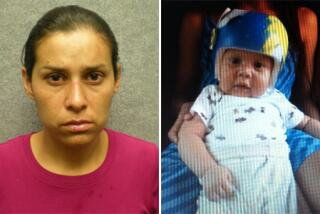Charges rejected in death of baby
- Share via
Prosecutors have long labeled USC student Holly Ashcraft a murderer.
The 22-year-old, they alleged, hid her pregnancy and, after secretly giving birth, dumped her newborn son in a trash bin near a popular campus hangout.
But over the last two years, two Los Angeles County Superior Court judges questioned whether there is enough evidence to charge her with murder.
On Thursday, a third judge rejected the efforts of the Los Angeles County district attorney’s office to reinstate the murder charge and also tossed out a charge of involuntary manslaughter.
Instead, Judge Kathleen Kennedy said Ashcraft should face a single charge of child abuse causing death, which carries a maximum sentence of 10 years in state prison.
“What she’s done is disturbing . . . it’s disgusting . . . but I don’t think the people have proven murder,” Kennedy said. “The evidence is not there.”
Ashcraft’s attorney, Mark Geragos, argued that the baby was stillborn and that Ashcraft acted without malice in disposing of the child.
“There was absolutely no evidence this was a live birth, not one scintilla of evidence,” Geragos said.
Officials in the district attorney’s office declined to comment on the judge’s decision. But they said that they would review court transcripts and the evidence before making any final decision on whether to appeal the judge’s ruling.
Ashcraft, a native of Billings, Mont., was arrested in October 2005 and charged with abandoning her newborn son in a trash bin near her apartment north of the USC campus. Police said the child was placed inside a cardboard box and left in the bin. A homeless man picking through the trash discovered the child and called police.
Until being suspended after her arrest, Ashcraft was a third-year architecture student.
Adding to the mystery surrounding her case, Ashcraft also was investigated by police, but not arrested or charged, in April 2004 after she arrived at a Los Angeles hospital having just given birth but without a baby.
She told authorities that the child was stillborn and that she had disposed of its body. Law enforcement sources said police did not do an extensive search for the child’s body because they believed too much time had passed to determine if a crime had been committed.
Ashcraft’s arrest made national headlines, but the legal case quickly centered on whether her baby was alive at birth.
Deputy Medical Examiner David B. Whiteman concluded that the boy had been born alive, after a 32-week pregnancy, and said his homicide finding was based on “caretaker neglect.”
Whiteman’s written opinion said the death resulted from “prematurity and other undetermined factors,” adding that “intentional asphyxia cannot be excluded.”
But, over the last year, three separate judges have raised questions about the prosecution’s murder case.
In February, Judge David Wesley questioned whether there was “malice” involved in Ashcraft’s actions.
“The whole prosecution’s case rests on whether the child lived for any appreciable time after it came out of the birth canal, if it lived at all,” Wesley said. “That is the issue in this case. . . . There are a lot of ifs.”
A month later, Wesley tossed out the murder charge.
In June, another judge reinstated the murder charge -- but then it was thrown out again.
Under California law, prosecutors can file the same charges twice.
If charges are dismissed two times, prosecutors are barred from filing a third time.
Prosecutors still could pursue the lesser charge of child abuse causing death against Ashcraft, who is out on bail.
Jean Rosenbluth, director of legal writing and advocacy and adjunct professor at USC’s law school, said that although the refiling is fairly unusual, it is not unheard of when a prosecutor truly believes the defendant has a case to answer.
“At [the] very least, prosecutors here have a case of child abuse,” she said. “Clearly the prosecutors believe they have a case against this young woman.”
Loyola Law professor Laurie Levenson said prosecutors may have had more success going for the lesser charge but were using Ashcraft to send a message.
“She is college-educated, had the resources [to deal with an unwanted pregnancy] and had a prior incident while she was pregnant,” Levenson said. “Those were aggravating factors leading to the higher charges. It was a bold move that didn’t pay off.”
richard.winton@latimes.com
More to Read
Sign up for Essential California
The most important California stories and recommendations in your inbox every morning.
You may occasionally receive promotional content from the Los Angeles Times.













